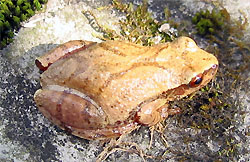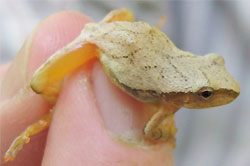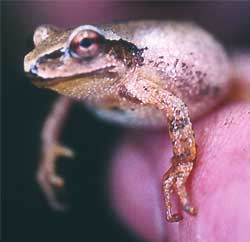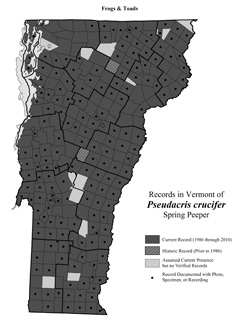Pseudacris crucifer
Spring Peeper
Identification
The Spring Peeper is one of Vermont’s smallest frogs. Adults are generally 1-1½ inches long. The Spring Peeper has no dorsolateral ridges. It has dark markings on its back that usually form an “X”, and small adhesive discs on its toes. Spring Peepers vary in color from light to dark brown. Adult males are generally smaller than the adult females, and breeding males have black throats and swollen thumbs.
Its call can either be a short ascending whistle or it may be broken into a series of ascending peeps. It begins calling as early as March, and can be heard through July. The peak calling time is around the beginning of May.
After mating, Spring Peepers lay hundreds of eggs singly or in packages of 2-3 eggs attached to vegetation. Tadpoles metamorphose within 2-3 months.
Range/Habitat
Adults can be found in herbaceous vegetation or woods next to heavily vegetated swamps and marshes of all sizes.
Status
Spring Peepers are very common in Vermont. This species has a state natural heritage rank of S5 (common). Please report sightings of this species in Vermont if you have not reported them within the last five years from a given location. Any natural history observations (feeding, migrations, road crossing areas, early or late season appearance, abnormalities, etc.) are appreciated. Photographs are always helpful, particularly if your report is the first report of this species from a town.
More Info
- Pseudacris crucifer at Animal Diversity website
- Pseudacris crucifer at Amphibiaweb
- Pseudacris crucifer at the CARCNET website
- Pseudacris crucifer at the Yale Peabody Museum website
- Listen to calls
at AmphibiaWeb (two recordings, both .mp3 format)
at Animal Diversity (.wav format)
at CARCNET (.wav format)
at Frog Quiz (QuickTime format)
or at Yale Peabody Museum (.wav format)
Species summary written by Kaile Burgess.



